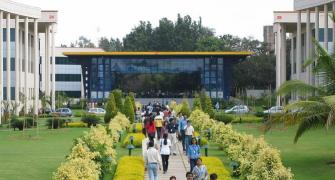
Infosys on Tuesday reported a strong set of numbers in the Q1 of FY16, especially in terms of revenue growth.
Chief executive and managing director Vishal Sikka and chief financial officer Rajiv Bansal tell Business Standard that with the company returning to industry-level growth path, the improvement in profitability would follow.
Edited excerpts:
While the revenue growth has been very good, the profit as well as profit margin seems to be under pressure. Is it a temporary phenomenon because as a part of the 2020, you want to achieve a healthy margin of 30 per cent?
Sikka: We have three dimensions to the 2020 aspirations that I have laid out: $20 billion in revenues, 30 per cent in operating profit margins and $80,000 in revenue per employee.
I actually believe, given the adoption of software and IP-led services in our workplace, all three are achievable.
The $80,000 revenue per employee is something that we will get through quite easily.
But the 30 per cent margin will be a more difficult thing to achieve, based on the understanding that I have right now.
But it can change with time. I feel, given where we are headed, the goal is certainly a desire that is viable. We are working towards that.
Bansal: A lot of these initiatives require investments ahead of time.
Otherwise, you can’t have revenue without investments ahead of time.
There is always a fine balance between the investments and the current revenue.
Our first priority is to get back to industry-level growth roads. You have seen the return to industry level growth now.
The next thing is to make investments in automation of services that will fetch us better margins.
As we achieve the $80,000 revenue per employee goal that Vishal has laid out, the 30 per cent margins will happen.
For that, we have to make investments. So the margins are to be looked at medium and long-term perspective than quarter-to-quarter.
In the quarter, Infosys’ time and material contracts revenue share seems to have risen at the cost of fixed price ones. Is it not something unusual when the company wants to position itself as a next generation services company, where newer revenue models like fixed price should grow faster?
Bansal: This split of revenue varies on quarter-to-quarter basis.
Over a period of time, our fixed price had actually grown up to 45 per cent. It is also a mix of projects we are executing at any point of time, and not something that we could measure on quarter-to-quarter basis. Well, yes, the clients are moving more towards managed services.
They want more for the costs that they are committing to.
So you will see more revenue coming from fixed projects.
Was the margin also got impacted negatively due to rise in visa costs?
Bansal: It’s not because of the visas.
The visa process usually happens in April. So this is a cost typically all information technology companies have factored in, in the first quarter.
If you recall, we had clearly stated that our margins would drop 50-80 basis points.
This is in line with the expense structure. With the first quarter gone by and the pyramid structure helping costs down, you will see margins grow. This is how the margins of any IT services company will look.
The IT services industry, including Infosys, is overly focusing on digitisation. But the size of the deals looks much smaller compared to multi-billion dollar engagement the industry was executing traditionally. Is it not a big concern?
Sikka: The deals that you are seeing from our newer initiatives may look small, but the impact on the others (clients) is huge.
You might to do $1 million or 0.5 million projects with one of the top 10 clients, but it will instill such a confidence in them that the other stuff moves forward.
The result of the top 10 clients growing by 5.7 per cent (in Q1 FY16) is not because they are doing 20 new projects, suddenly. But continuation and innovation in these projects are instilling confidence in them to do more projects.
During your interactions with analysts, you had said the second half of the year would be better than the first as you are expecting newer initiatives to show results. Do you stand by that?
Sikka: Historically, in the second half the financial year, which is October to March, we perform worse than the first.
And this year, we are being particularly cautious about that.
The initiatives we talked about would continue to pick steam.
So far, we have seen a very strong growth in these areas even though the numbers are still quite small.
The strategic initiatives are starting to show up meaningfully in our performance.
As we go towards the second half of the financial year, the impact of these would become bigger and bigger.
So we are cautiously optimistic and we are watching very carefully to see that the second half is not like the usual softness we see typically.









